Wallbox / charging station comparison
Are you looking for a wallbox or a charging station? Our wallbox and charging station comparison will help you choose the right product. We compare wallboxes and charging stations from top manufacturers such as EVBox, Fronius, GoodWe, Kostal, Hardy Barth, SMA, Sungrow, ABL, Mennekes, E3/DC, EnerCharge, SolarEdge, Wallbox and KEBA.
Why a wallbox?
Go green. There are wallboxes that can charge the electric cars directly with the electricity generated by its own PV system. In other words, the electric car is charged with the excess PV power from the PV system. This function is called PV surplus charging. Again, a distinction is made between pure PV charging and mixed charging.
Safety is the most important thing. Household sockets are not designed for regular, heavy-load charging. However, a wallbox offers much more protection than a normal socket, as the manufacturers build in protection against DC and AC faults. At the same time, a wallbox offers more charging power and therefore shorter charging times. An AC wallbox can handle up to 22 kW, while a DC wallbox can handle up to 40 kW.
Wallbox or charging station?
Wallboxes are made for private and semi-public use and can simply be screwed to the wall. The charging power ranges from 3.7 kW to 22 kW.
The charging stations are mostly located in public areas, but also in semi-public areas. They are built to withstand the adverse effects of wind, weather and vandalism. Charging stations are usually also equipped with access control and 2 type 2 sockets. This means that 2 cars can be charged in parallel. The charging power of 22 kW or 44 kW is higher than that of a wallbox.
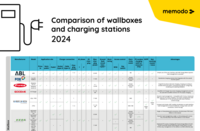
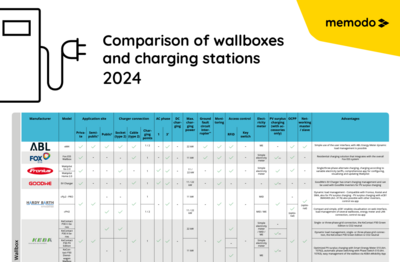
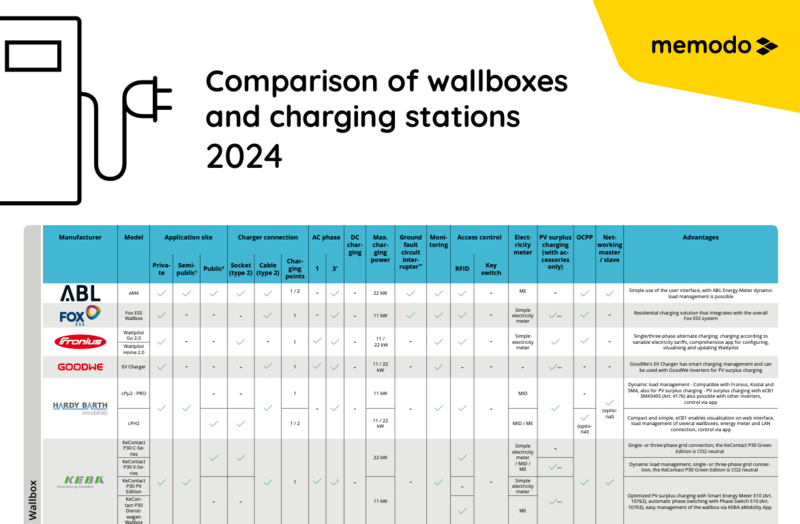
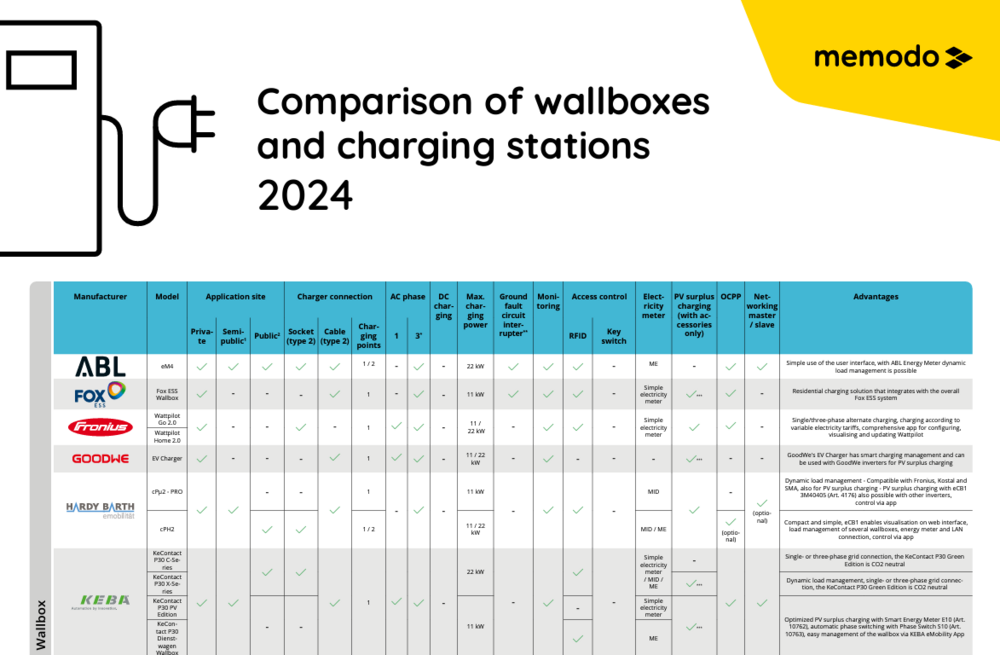
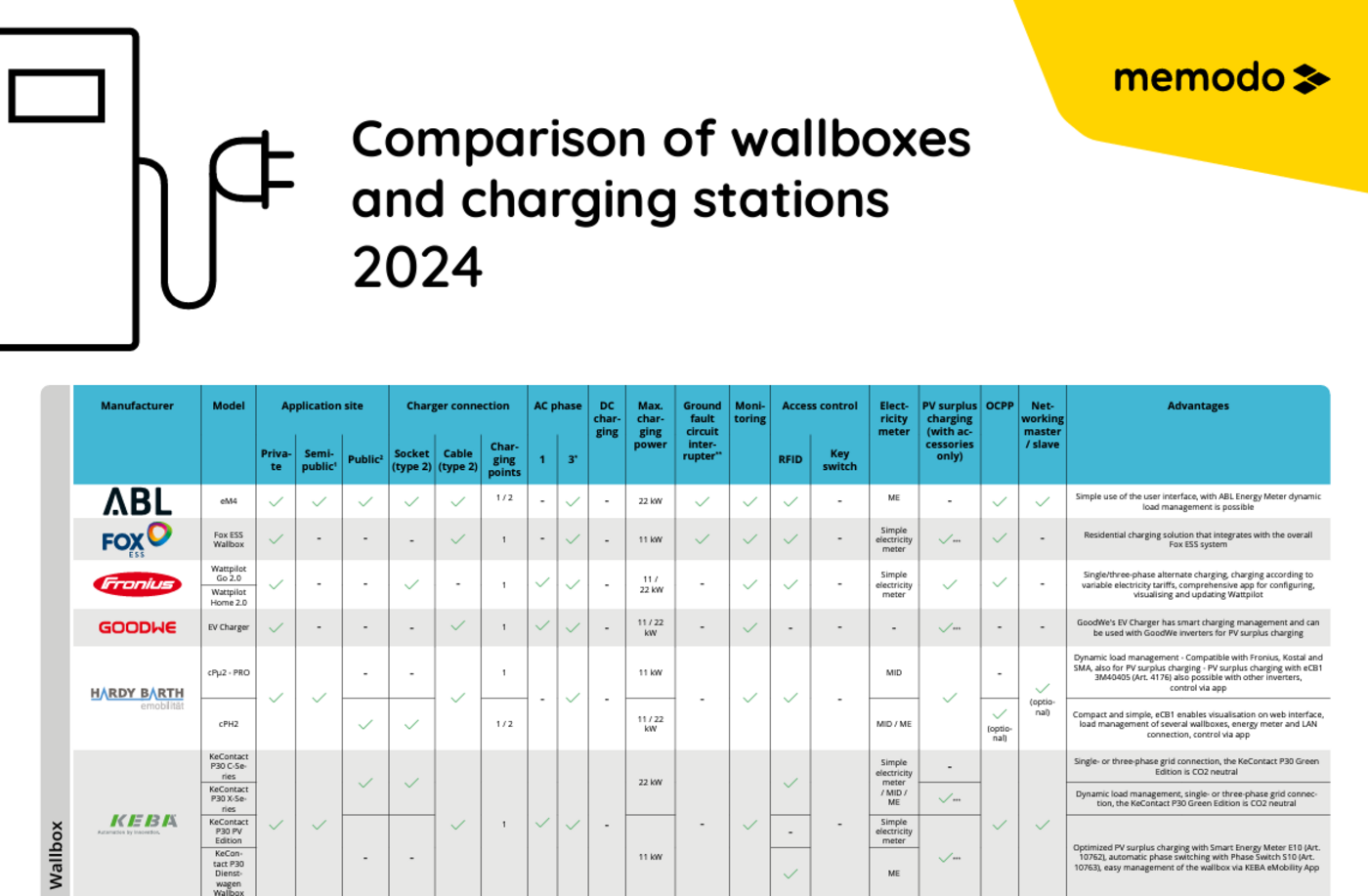
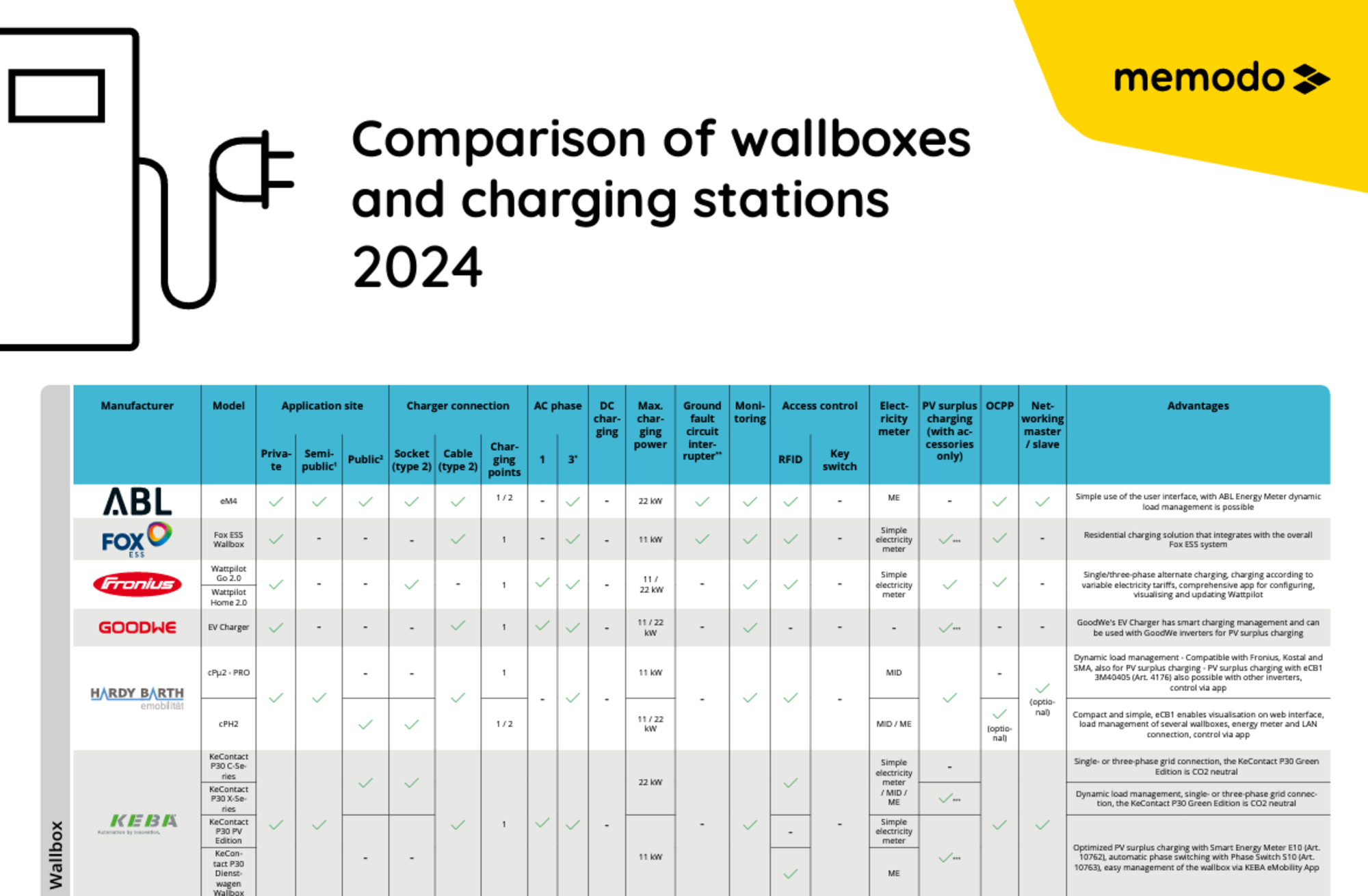
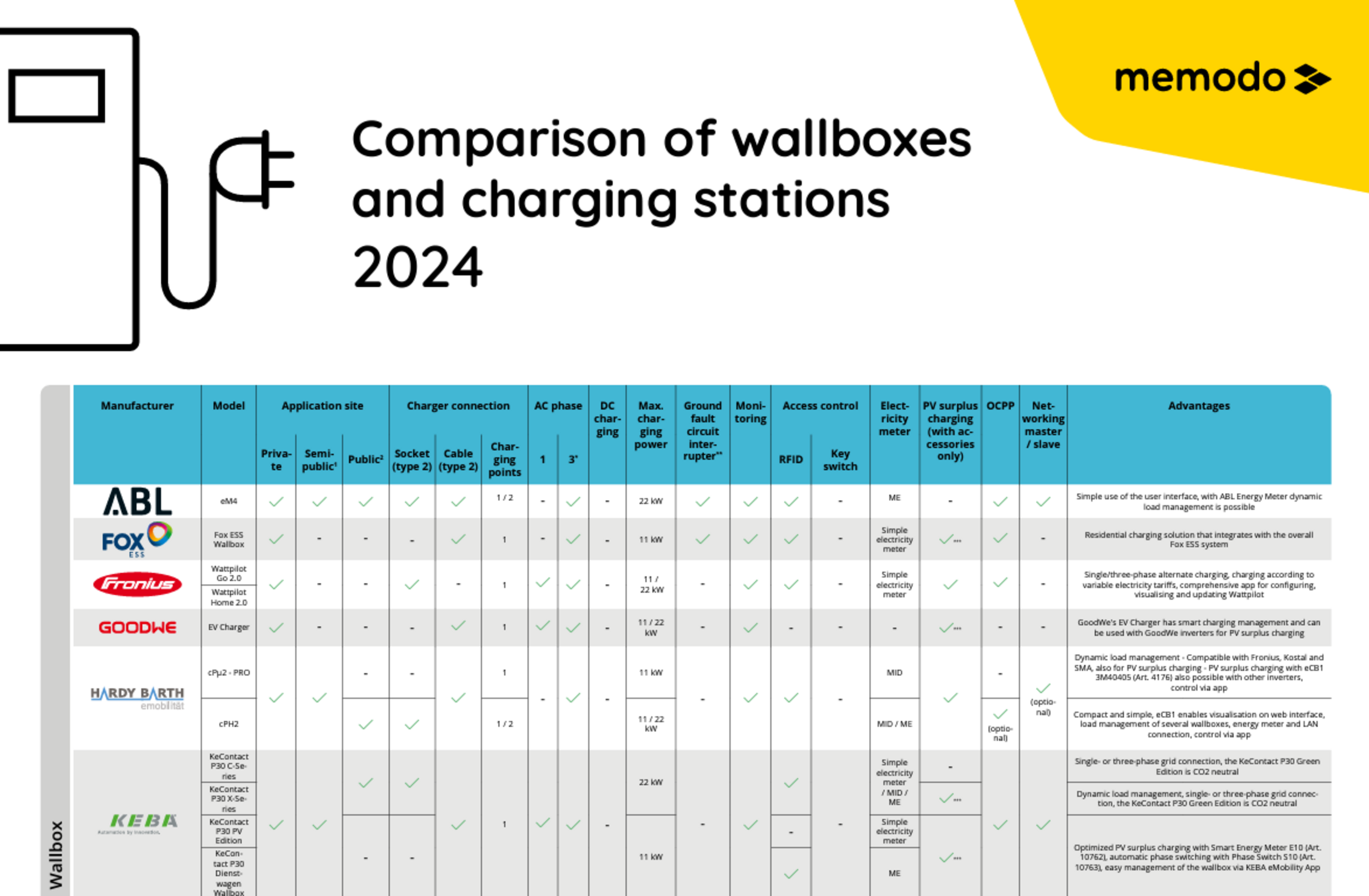

These are the features we look at when comparing wallboxes and charging stations:
- Place of use: private, semi-public and/or public
- Charging connection: Socket or cable? How many charging points?
- AC phases: 1- or 3-phase?
- DC charging yes or no?
- Maximum charging power
- RCD (Residual Current protective Device)
- Monitoring
- Access control: RFID or key switch
- Energy meter included?
- Surplus charging with PV
- OCPP communication protocol
- Master/slave or hub/satellite networking
The distinguishing features in the wallbox / charging stations comparison
Place of use
You can install an e-charging station in a public space, in a semi-public space or on private property. Charging points on the street are located in the public space, while a semi-public space is, for example, the car park of a hotel or a parking garage.
Charging socket
Each electric charging station has either a charging socket or a charging cable, both with a type 2 plug. The cables are between 4 m and 7.5 m long, depending on the supplier. You can buy the cables in a straight or coiled version. Most wallboxes have one charging point, while all charging stations have two. The maximum available current is then divided between the two charging points.
AC phases
Wallboxes can be connected to the household grid in 1-phase or 3-phase mode. Wallboxes connected in 3 phases have a higher charging capacity than those connected in 1 phase.
DC charging
DC Wallboxes or DC Fast Chargers charge electric vehicles faster because the electric vehicle can absorb the DC current directly. This means more charging power is available and the charging time is significantly reduced.
Charging power
The maximum charging power of the wallboxes depends on the number of phases and the rated current. It is calculated as follows:
P = Phase × 230 V × Rated Current
The maximum charging power of the on-board charger in the electric vehicle influences the charging power of the wallbox. It is always the weakest link that counts.
For example: A Tesla Model S will only charge at a maximum of 16.5 kW, even with a 22 kW wallbox, because the on-board charger will not allow more charging.
Protection
Unlike a household socket, the wallbox offers additional protection. All the wallboxes we offer are equipped with DC fault current detection. In some electric charging stations you will also find a residual current device for protection. If the RCD is not installed in the wallbox, you will have to install it externally, which means additional costs. Together with the already installed DC residual current detection, at least a type A RCD is required, but type A EV or type B are also permissible.
Monitoring
In most cases, the charging station can be monitored and controlled via a smartphone app or a web interface. For example, the user can pause the charging process in the app or check the maximum charging power.
Energy meter
The amount of electricity used to charge the EV can be measured in the wallboxes and charging stations. Choose the energy meter that suits your application. There is a simple digital meter used in the private sector. An MID-compliant meter is useful for billing between employee and employer in the private and semi-public sectors. The ME meter (metering and calibration law-compliant meter) is required for billing accurate to the kilowatt hour, e.g. in the public sector.
Access control
If the e-charging station is to be restricted to certain users, then there are a number of control measures. The simplest is an integrated key switch that allows users to turn the wallbox on and off with a key. With some wallboxes, this key switch can also be used to set additional functions, such as fast charging or eco mode. Another option is to control access via an RFID system. Here, each user is given a card with which they can activate the charging station or wallbox. The advantage of this card over a key switch is that more people can use the wallbox and it is possible to track who has used how much electricity.
PV surplus charging
Some wallboxes and charging stations are controlled by an energy management system and charge using the solar energy produced by their own PV system. Any surplus energy not consumed by household loads is then used to charge the electric vehicle.
Open Charge Point Protocol (OCPP) communication protocol
The OCPP enables communication between the charging station and a central management or back-end system. This communication is the basis for calibration complaint billing, as the data is securely sent to the back-end system. The OCPP is independent of system suppliers and can therefore be integrated easily and universally.
Hub/satellite or master/slave networking
Some manufacturers offer hub/satellite or master/slave networking of the wallboxes. In most cases, a master or hub wallbox is sufficient to control other wallboxes, known as satellite or slave wallboxes. The advantage of this is that you only have to buy one 'expensive' wallbox and can still use its functions for the other wallboxes. One intelligent charging station (master/hub) has the gateway to the backend and all other charging stations (satellite/slaves) are connected to the master charging station. The number of wallboxes you can connect depends on the manufacturer.
Important for wallboxes:
- Obligation to register with the grid operator: All wallboxes
- Approval from the grid operator: Wallboxes with maximum charging power > 12 kV